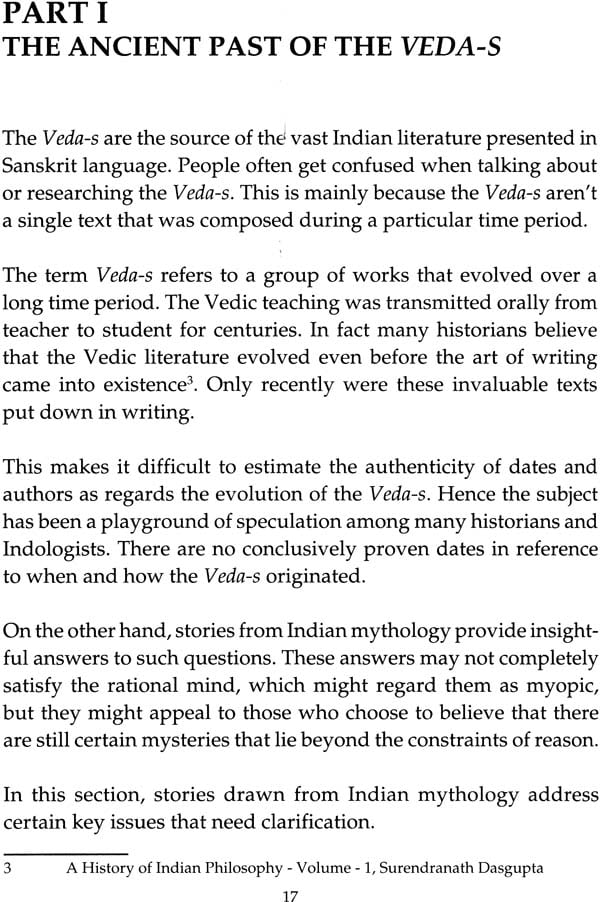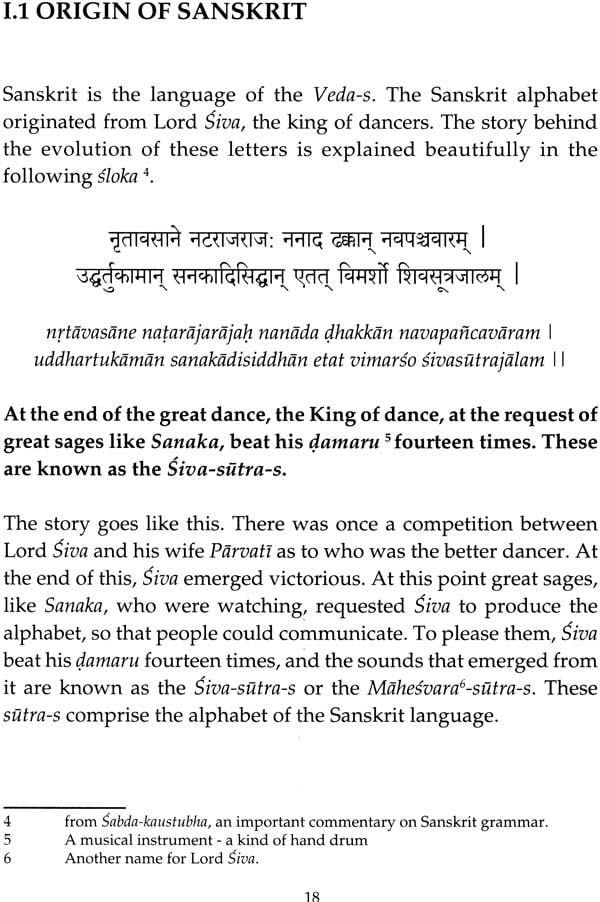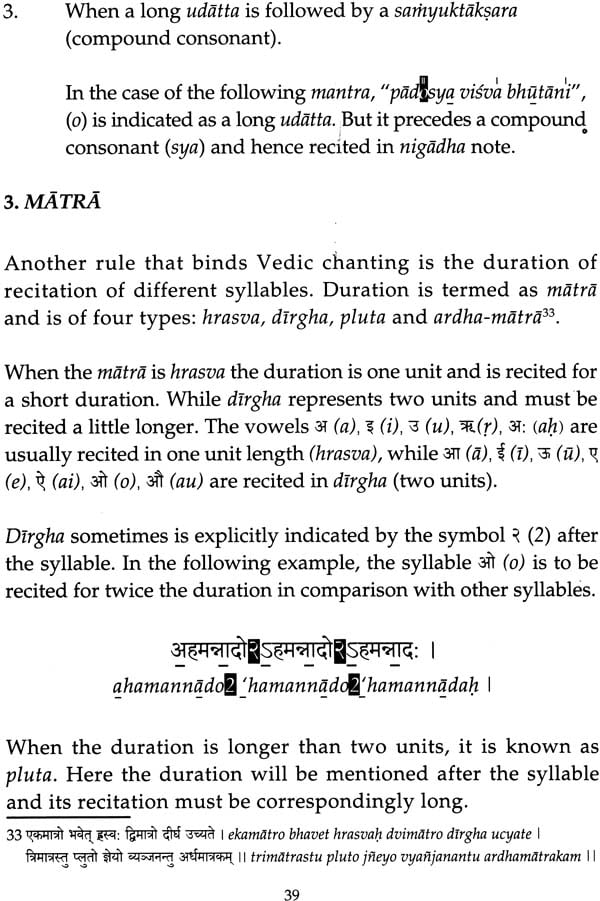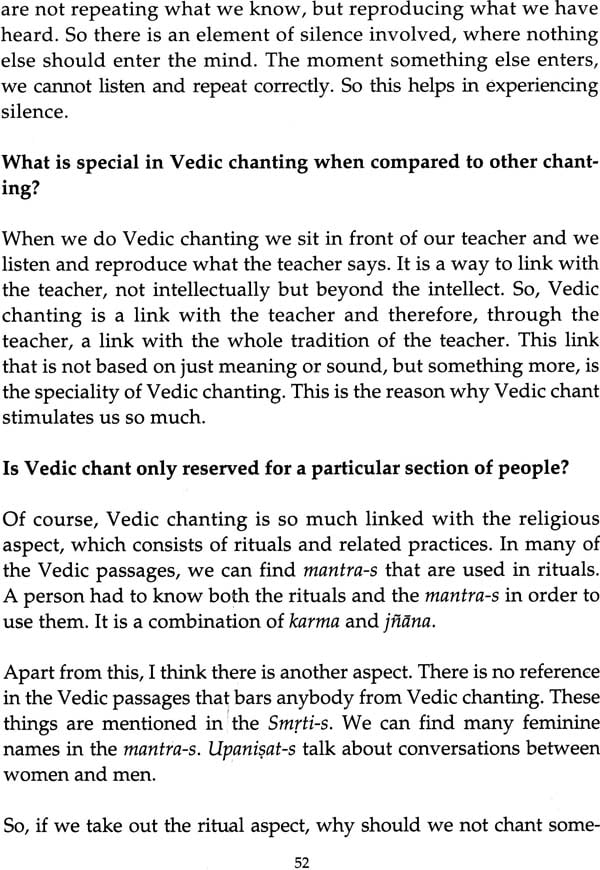
A Guide to Vedic Chanting
Book Specification
| Item Code: | NAH813 |
| Author: | TKV Desikachar and Dr. Kausthub Desikachar |
| Publisher: | Media Garuda: Krishnamacharya Healing and Yoga Foundation |
| Language: | English |
| Edition: | 2022 |
| ISBN: | 9788192071657 |
| Pages: | 66 |
| Cover: | Paperback |
| Other Details | 8.0 inch X 6.0 inch |
| Weight | 110 gm |
Book Description
The Veda-s are ancient scriptures in the Sanskrit language. Traditionally, it is believed that the Veda-s are the breath of the Lord and hence eternal, not composed by humans but revealed to ancient seers while in a deep meditative state. Considered complete and impeccable, they wield high influence on Indian scriptures and are held sacred by millions to this day. Due to this belief in their divine origin, even those Vedic verses where the rules of Sanskrit Grammar seem to be violated, are recited unchanged.
Modern research claims that the Veda-s were composed by Indo-Aryans many centuries before the birth of Christ. There are innumerable such theories of origin put forward by different historians, the validity of which continue to be a source of debate. The only aspect of the Veda-s that has never been contested is the manner of their recitation. Bound by a set of strict rules, they continue to be chanted today in exactly the same way as they were in the distant past.
In the ancient past, Vedic chanting formed part of daily activity in everyone's life as all the rituals were based on the Veda-so There are many stories in Indian mythology that highlight this. However with the advent of time, due to unknown reasons, only men from a certain section of the society (Brahmins) were allowed to learn and chant the Veda-so.
Today, Vedic chanting is no longer confined to a particular sect. Great Vedic scholars like Vedakesari Sri T Krishnamacharya’s, taught Vedic chanting to a variety of people without discrimination, using the authority from the Dharma-sastra which says "in times of crisis anyone, even if not a brahmin can do chant the Veda-s." Thanks to great Acarya-s like him, the benefits of Vedic chanting can be reaped by all.
'A Guide to Vedic Chanting' has been compiled to orient a beginner in the art of Vedic chanting to its history and technique. It will serve as a useful resource when embarking on the magical, potent journey of sacred sounds.
The Veda-s are the oldest and most authoritative of Indian Scriptures. Proclaimed to be the voice of the Lord that was heard by the Rsi-s of yore, they are sacred to millions around the world who chant them with great reverence and attention to detail.
The dates of origin of the Veda-s have been widely contested, and there exist innumerable theories proposed by different historians on this matter. Regardless of this, one aspect of the Veda-s that has never been contested is the manner of their recitation. Bound by a set of strict rules, Veda-s are chanted the same way now, as in the distant past.
It is believed that no human has the authority to modify the way the Veda-s were presented by the Lord. Even those verses wherein Sanskrit grammar would not allow a particular construction of words, are recited unchanged owing to the sanctity of the Lord's voice.
In the ancient past, Vedic chanting formed part of daily activity in everyone's life. Stories in Indian mythology highlight this. As history evolved, things slowly began to change. Women were barred from Vedic chanting. Only the Brahmin caste was allowed to chant. Reasons for this transformation are unknown.
Now Vedic chanting is becoming accessible to various sections of people. Great Vedic scholars like Vedakesari Sri T Krishnamacharya, who himself had orthodox views in his earlier days, later changed his views and actually began teaching Vedic chanting to a variety of people. He used the authority from the Sastra-s to prove that Vedic chanting could be done by anybody, as long as the rules of chanting were respected. In this context, he quoted the Dharma-sastra which says, "in times of crisis anyone, even if not a Brahmin, can chant the Veda-s."
Thanks to great Acarya-s like him, the benefits of Vedic chanting are being reaped all across the world today.
This 'Guide to Vedic Chanting' is not a teach-yourself manual on chanting. It only serves as an aid to Vedic-chant practitioners, who themselves are learning from a teacher.
While great care has been taken to ensure correctness, the reader is requested to forgive any inadvertent errors in this presentation.
Contents
| SANSKRIT ALPHABETS | 9 | |
| PRONUNCIATION GUIDE | 11 | |
| FIRST WORDS | 15 | |
| PART -I | THE ANCIENT PAST OF THE VEDA-S | 17 |
| I.1 | Origin of Sanskrit | 18 |
| I.2 | The Dawn of the Veda-s | 20 |
| I.3 | Evolution of the Veda-s | 22 |
| I.4 | Presentation of the veda-s | 25 |
| PART -II | VEDIC CHANT PEDAGOGY | 27 |
| II.1 | Rules of Vedic Chant | 29 |
| II.2 | Other Chant Pedagogy | 45 |
| II.3 | Other aspects of Vedic Chanting | 49 |
| PART-III | PRAVACANAM | 51 |
| GLOSSARY | 58 |











